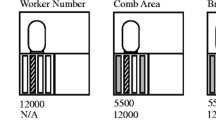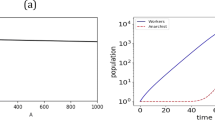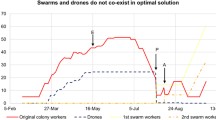Abstract
Social insect colonies display a remarkable ability to adjust investment in reproduction (i.e., production of sexuals) in accordance with environmental conditions such as season and food availability. How this feat is accomplished by the colony’s queen(s) and workers remains a puzzle. Here, I review what we have learned about this subject in the European honeybee (Apis mellifera), specifically with regard to a colony’s production of males (drones). I identify five environmental conditions that influence colony-level patterns of drone production and then define five stages of drone rearing that are accomplished by the queen and workers. Using this framework, I detail our current understanding of how the queen or workers adjust their actions at each stage of drone rearing in response to each of the environmental conditions. Future investigations of this topic in honeybees and other social insect societies will lead to a better understanding of how colonies manage to flexibly and efficiently allocate their resources under changing environmental conditions.

Similar content being viewed by others
References
Allen M.D. 1958. Drone brood in honeybee colonies. J. Econ. Entomol. 51: 46–48
Allen M.D. 1963. Drone production in honey-bee colonies (Apis mellifera L.). Nature 199: 4895–4896
Allen M.D. 1965a. The effect of a plentiful supply of drone comb on colonies of honeybees. J. Apic. Res. 4: 109–119
Allen M.D. 1965b. The production of queen cups and queen cells in relation to the general development of honeybee colonies and its connection with swarming and supersedure. J. Apic. Res. 4: 121–141
Beekman M., Komdeur J. and Ratnieks F.L.W. 2003. Reproductive conflicts in social animals: who has power? Trends Ecol. Evol. 18: 277–282
Beekman M. and Ratnieks F.L.W. 2003. Power over reproduction in social Hymenoptera. Phil. Trans. R. Soc. Lond. B Biol. Sci. 358: 1741–1753
Berg S., Koeniger N., Koeniger G. and Fuchs S. 1997. Body size and reproductive success of drones (Apis mellifera L). Apidologie 28: 449–460
Bourke A.F.G. and Franks N.R. 1995. Social Evolution in Ants. Princeton University Press, Princeton, N.J. 529 pp.
Buhler A., Lanzrein B. and Wille H. 1983. Influence of temperature and carbon dioxide concentration on juvenile hormone titer and dependent parameters of adult worker honeybees (Apis mellifera L). J. Insect Physiol. 29: 885–893
Camazine S. 1991. Self-organizing pattern formation on the combs of honeybee colonies. Behav. Ecol. Sociobiol. 28: 61–76
Camazine S., Deneubourg J.-L., Franks N.R., Sneyd J., Theraulaz G. and Bonabeau E. 2001. Self-organization in Biological Systems. Princeton University Press, Princeton, N.J. 538 pp
Charnov E.L. 1982. The Theory of Sex Allocation. Princeton University Press, Princeton, N.J. 355 pp
Crozier R.H. and Pamilo P. 1996. Evolution of Social Insect Colonies. Oxford University Press, Oxford. 306 pp
Darwin C. 1874. The Descent of Man, and Selection in Relation to Sex (2nd edition). John Murray, London.
Delaplane K.S. and Harbo J.R. 1987. Drone production by young versus old worker honeybees in queenless colonies. Apidologie 18: 115–119
Free J.B. 1957. The food of adult drone honeybees (Apis mellifera). Brit. J. Anim. Behav. 5: 7–11
Free J.B. 1967. The production of drone comb by honeybee colonies. J. Apic. Res. 6: 29–36
Free J.B. and Williams I.H. 1975. Factors determining the rearing and rejection of drones by the honeybee colony. Anim. Behav. 23: 650–675
Fukuda H. and Ohtani T. 1977. Survival and life span of drone honeybees. Res. Popul. Ecol. 19: 51–68
Hamilton W.D. 1964. The genetical evolution of social behavior. J. Theor. Biol. 7: 1–16
Haydak M.H. 1958. Do the nurse honeybees recognize the sex of the larvae? Science 127: 1113
Henderson C.E. 1991. Reproductive Investment in Drones in Honey Bee (Apis mellifera) Colonies. Cornell University, Ithaca, N.Y. 92 pp
Henderson C.E. 1994. Influence of the presence of adult drones on the further production of drones in honeybee (Apis mellifera L) colonies. Apidologie 25: 31–37
Hrassnigg N. and Crailsheim K. 2005. Differences in drone and worker physiology in honeybees (Apis mellifera). Apidologie 36: 255–277
Johansson T.S.K. and Johansson M.P. 1971. Effects of drone comb on brood and honey production in honeybee Apis mellifera (Hymenoptera-Apidae) colonies. Ann. Entomol. Soc. Am. 64: 954–956
Koeniger N. 1970. Factors determining the laying of drone and worker eggs by the queen honeybee. Bee World 51: 166–169
Kronauer D.J.C., Schoning C., Pedersen J.S., Boomsma J.J. and Gadau J. 2004. Extreme queen-mating frequency and colony fission in African army ants. Mol. Ecol. 13: 2381–2388
Lee P.C. and Winston M.L. 1985. The effects of swarm size and date of issue on comb construction in newly founded colonies of honey bees (Apis mellifera L.). Can. J. Zool. 63: 524–527
Lee P.C and Winston M.L. 1987. Effects of reproductive timing and colony size on the survival, offspring colony size and drone production in the honeybee (Apis mellifera). Ecol. Entomol. 12: 187–195
Martin C.G., Oldroyd B.P. and Beekman M. 2004. Differential reproductive success among subfamilies in queenless honeybee (Apis mellifera L.) colonies. Behav. Ecol. Sociobiol. 56: 42–49
Martin S.J., Beekman M., Wossler T.C. and Ratnieks F.L.W. 2002. Parasitic Cape honeybee workers, Apis mellifera capensis, evade policing. Nature 415: 163–165
Miller D.G. and Ratnieks F.L.W. 2001. The timing of worker reproduction and breakdown of policing behaviour in queenless honeybee (Apis mellifera L.) societies. Insect. Soc. 48: 178–184
Moritz R.F.A. 1985. The effects of multiple mating on the worker–queen conflict in Apis mellifera L. Behav. Ecol. Sociobiol. 16: 375–377
Morse R.A., Strang G.E. and Nowakowski J. 1967. Fall death rates of drone honeybees. J. Econ. Entomol. 60: 1198–1202
Newton D.C. and Michl D.J. 1974. Cannibalism as an indication of pollen insufficiency in honeybees: ingestion or recapping of manually exposed pupae. J. Apic. Res. 13: 235–241
Page R.E. 1981. Protandrous reproduction in honeybees. Environ. Entomol. 10: 359–362
Page R.E. and Erickson E.H. 1988. Reproduction by worker honeybees (Apis mellifera L). Behav. Ecol. Sociobiol. 23: 117–126
Page R.E. and Metcalf R.A. 1984. A population investment sex ratio for the honeybee (Apis mellifera L). Am. Nat. 124: 680–702
Palmer K.A. and Oldroyd B.P. 2000. Evolution of multiple mating in the genus Apis. Apidologie 31: 235–248
Pratt S.C. 1998. Decentralized control of drone comb construction in honey bee colonies. Behav. Ecol. Sociobiol. 42: 193–205
Pratt S.C. 2004. Collective control of the timing and type of comb construction by honeybees (Apis mellifera). Apidologie 35: 193–205
Ratnieks F.L.W., Foster K.R. and Wenseleers T. 2006. Conflict resolution in insect societies. Annu. Rev. Entomol. 51: 581–608
Ratnieks F.L.W. and Keller L. 1998. Queen control of egg fertilization in the honeybee. Behav. Ecol. Sociobiol. 44: 57–61
Rheindt F.E., Gadau J., Strehl C.P. and Hölldobler B. 2004. Extremely high mating frequency in the Florida harvester ant (Pogonomyrmex badius). Behav. Ecol. Sociobiol. 56: 472–481
Rinderer T.E., Hellmich II R.L, Danka R.G. and Collins A.M. 1985. Male reproductive parasitism: a factor in the africanization of European honey-bee populations. Science 228: 1119–1121
Robinson G.E., Page R.E. and Fondrk M.K.. 1990. Intracolonial behavioral variation in worker oviposition, oophagy, and larval care in queenless honeybee colonies. Behav. Ecol. Sociobiol. 26: 315–323
Sasaki K., Kitamura H. and Obara Y. 2004. Discrimination of larval sex and timing of male brood elimination by workers in honeybees (Apis mellifera L.). Appl. Entomol. Zool. 39: 393–399
Sasaki K. and Obara Y. 2001. Nutritional factors affecting the egg sex ratio adjustment by a honeybee queen. Insect. Soc. 48: 355–359
Sasaki K., Satoh T. and Obara Y. 1996. The honeybee queen has the potential ability to regulate the primary sex ratio. Appl. Entomol. Zool. 31: 247–254
Schmickl T., Blaschon B., Gurmann B. and Crailsheim K. 2003. Collective and individual nursing investment in the queen and in young and old honeybee larvae during foraging and non-foraging periods. Insect. Soc. 50: 174–184
Schmickl T. and Crailsheim K. 2001. Cannibalism and early capping: strategy of honeybee colonies in times of experimental pollen shortages. J. Comp. Physiol. A 187: 541–547
Schmickl T. and Crailsheim K. 2002. How honeybees (Apis mellifera L.) change their brood care behaviour in response to non-foraging conditions and poor pollen conditions. Behav. Ecol. Sociobiol. 51: 415–425
Seeley T.D. 2002. The effect of drone comb on a honeybee colony’s production of honey. Apidologie 33: 75–86
Seeley T.D. and Mikheyev A.S. 2003. Reproductive decisions by honeybee colonies: tuning investment in male production in relation to success in energy acquisition. Insect. Soc. 50: 134–138
Seeley T.D. and Morse R.A. 1976. The nest of the honeybee (Apis mellifera L). Insect. Soc. 23: 495–512
Strassmann J. 2001. The rarity of multiple mating by females in the social Hymenoptera. Insect. Soc. 48: 1–13
Trivers R.L. and Hare H. 1976. Haplodiploidy and the evolution of the social insects. Science 191: 249–263
Visscher P.K. 1989. A quantitative study of worker reproduction in honeybee colonies. Behav. Ecol. Sociobiol. 25: 247–254
Webster T.C., Peng Y.S. and Duffey S.S. 1987. Conservation of nutrients in larval tissue by cannibalizing honeybees. Physiol. Entomol. 12: 225–231
Wharton K.E., Dyer F.C. and Getty T. 2008. Male elimination in the honeybee. Behav. Ecol. 19: 1075–1079
Wharton K. E., Dyer F.C., Huang Z.Y. and Getty T. 2007. The honeybee queen influences the regulation of colony drone production. Behav. Ecol. 18: 1092–1099
Winston M.L. 1987. The Biology of the Honey Bee. Harvard University Press, Cambridge, Massachusetts. 281 pp
Woyke J. 1977. Cannibalism and brood-rearing efficiency in the honeybee. J. Apic. Res. 16: 84–94
Acknowledgments
I thank F. C. Dyer, T. Getty and T. D. Seeley for helpful discussions on the ideas in this paper. Many thanks are due also to K. E. Holekamp, Z. Y. Huang and two anonymous reviewers for comments on a draft of this paper. My work was supported by an NSF fellowship on sequential decision-making (IGERT DGE 0114378).
Author information
Authors and Affiliations
Corresponding author
Rights and permissions
About this article
Cite this article
Boes, K.E. Honeybee colony drone production and maintenance in accordance with environmental factors: an interplay of queen and worker decisions. Insect. Soc. 57, 1–9 (2010). https://doi.org/10.1007/s00040-009-0046-9
Received:
Revised:
Accepted:
Published:
Issue Date:
DOI: https://doi.org/10.1007/s00040-009-0046-9




